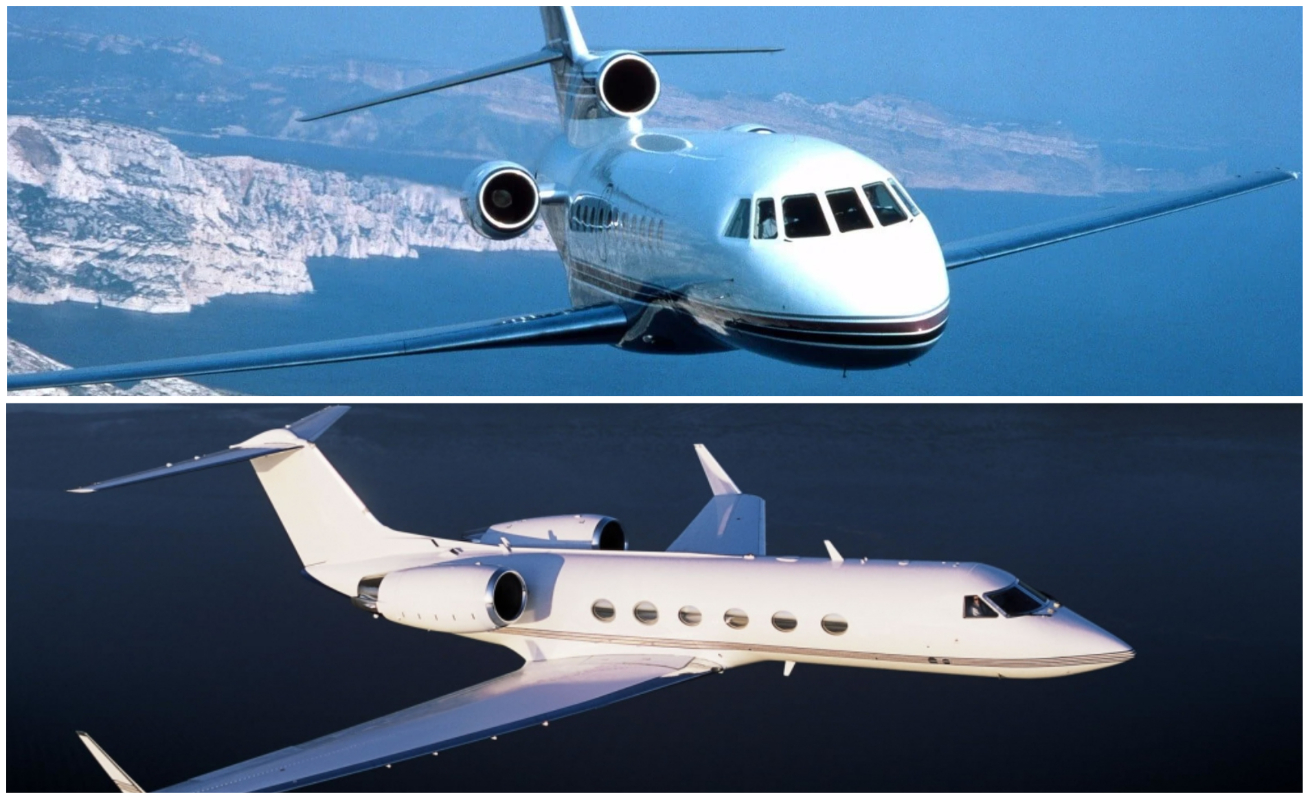Comparing the Gulfstream IV and Dassault Falcon 900 Business Jets
The Dassault Falcon 900 and the Gulfstream IV have been staples in business and luxury aviation for nearly 4 decades.

These heavy jets offer transcontinental, long-distance travel and room for more than a dozen passengers, with each model offering different seating capacities, cabin sizes, cargo capacity and range.
Both planes began production within a year of each other, with the Gulfstream IV entering production in 1983, and Dassault beginning production of the Falcon 900 in 1984.
The G4 private jet became an icon in luxury aviation and one of the most sought after business jets of the 80’s and 90’s, serving as the foundation for many future Gulfstream G-series models.
Variants of the GIV including the Gulfstream IV-SP and the Gulfstream G450. More than 900 combined models were produced during the GIV’s 30 year run, replaced by the Gulfstream G500 in 2018.
The Falcon 900 is still in production today, with more than 500 models produced including the popular Falcon 900EX, and the current model in the series, the Falcon 900LX.
The original Falcon 900 was replaced by the Falcon 900B in 1991, which will be the basis for this comparison to the original Gulfstream G-IV; the 900B included upgraded Garrett TFE731 engines with higher cruise speed and reduced runway take-off requirements.
Performance
The Dassault Falcon 900 offers versatile performance for corporate and luxury travel, reaching destinations many of its competitors can’t.
Cruising at speeds up to 590 mph (513 kts) and reaching a top speed of 667 mph (Mach 0.87), the Falcon 900 delivers outstanding speed, with a 7 passenger range of 4,598 nautical miles and fully-loaded range of nearly 4,000 nautical miles.
Many owners and operators enjoy the performance and peace of mind provided by the additional engine in its tri-jet design, but the addition thrust enhances short runway performance, allowing it to land at challenging, high-elevation airports many large-cabin business jets can’t operate at.
The Gulfstream IV raised the bar even higher for performance, with a maximum cruise speed of 652 mph (566 kts) and a top speed of 675 mph (Mach 0.88), while offering similar range at 4,220 nautical miles with a useful range of around 3,800 nmi.
Although the Gulfstream IV offers higher cruise and maximum speeds, the Falcon 900 offers access to a larger amount of destinations and airports, requiring a 5,015 ft runway for takeoffs and just a 2,775 ft runway to land, compared to the GIV’s landing requirements of a 3,812 ft runway.
Cabin
The Dassault Falcon 900 offered the first business jet with an isolated passenger cabin, featuring forward and aft lavatories and a galley separated from the flight crew and the cockpit.
The Falcon 900’s cabin measures 6′ 2″ tall, 7′ 8″ wide, and 33′ 2″ in length, for a total cabin volume of of 1,218 cubic feet. The cabin offers typical seating for 12 passengers and high-density configurations for up to 18-19 passengers, with 127 cubic feet of internal baggage space.
The Gulfstream IV offered one of the largest, most comfortable cabins of its time, becoming an icon in luxury aviation by the 1990’s.
The GIV offers a substantially larger cabin, measuring 6′ 1″ tall, 7′ 3″ wide, and nearly 12 feet longer at 45′ 1″, creating a total cabin volume of 1,658 cubic feet – that’s 440 cubic feet larger than the Falcon 900, around the size of a two car garage.
Standard configurations on the GIV carry more passengers, with seating for 13-14 passengers, and high-density layouts to also carry up to 19. The GIV also offers more baggage capacity, with 169 cubic feet available.
Costs
The Falcon 900 entered the market with an original price of around $21-$26 million USD, with pre-owned models available today for an average cost of between $5 million and $6 million.
The operating cost for the Falcon 900, based on 450 owner operated hours and $7 per gallon jet fuel, carries an annual budget of just over $3,000,000, with around $2.1 million in variable costs and $900k in fixed costs, coming out to hourly costs of around $6,600/hr.
Charter rates on the Falcon 900 average out to around $7,200 an hour, depending on the year of make, model, and other factors.
The Gulfstream IV was originally priced for between $26-$33 million, with models available on the pre-owned market for just over $6 million.
Operating costs for the Gulfstream G4, based on the same 450 hours & fuel prices, carries an annual budget of around $3,500,000, including variable costs of around $2.6 million and total fixed costs of just under $900,000. hourly costs for the GIV break down to around $7,900 per hour.
The cost to charter a Gulfstream IV can range between $7,500 and $9,000 an hour.
TL;DR
The Gulfstream GIV offers higher cruise and top speeds and a similar range to the Falcon 900, as well as a substantially larger cabin and room for 1 or 2 more passengers in standards cabin configurations.
The Falcon 900 offers better access to shorter runways, especially in harsh, high-altitude conditions thanks to the additional thrust provided by its tri-jet design. The Dassault Falcon 900 also carries lower operational costs, and can often be chartered for a lower rate than the Gulfstream IV.
Contact Us
Interested in renting a GIV, Falcon 900 or similar heavy jet for your next private flight? Air Charter Advisors offers instant access to business jet rentals wherever you’re located. Submit a request or give us a call at +1 (888) 987-5387 for a free charter quote or to discuss sales, jet cards, and other aviation services.

